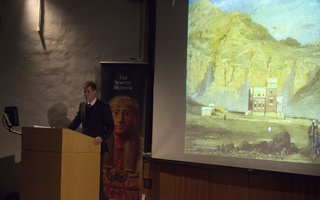{shortcode-644a08e2e114da3acfdc3a141daf28551369309f}The Semitic Museum is focusing its fundraising efforts on incorporating new technology into its exhibits to engage students in hands-on learning, as part of the Faculty of Arts and Sciences’ portion of Harvard’s ongoing capital campaign.
Between $10 and $50 million would be needed to renovate the museum building and gallery spaces, increase digitization efforts, and pursue international collaborations among other initiatives, according to Semitic Museum Director and Egyptology professor Peter Der Manuelian ’81.
“My goal is to revitalize the place further,” Der Manuelian said. “So I want to make this an exciting destination on campus. I’d love it if every undergraduate would set foot in the building at least once, and preferably more than once before they graduate.”
The Semitic Museum’s fundraising takes place under the “Leading in Learning” category of the FAS campaign, which was well below its goal as of October.
“The teaching and learning aspect of what we do and what the individual museums do, that’s one of the campaign buckets,” Jane Pickering, the executive director of the six Harvard Museums of Science and Culture, said. The Semitic Museum is one of the six museums.
Pickering also said financial support for the museums has come in many forms, including revenues from memberships, donors, federal funding, and various foundations.
Making museum exhibits into better resources for learning was a priority, Der Manuelian said.
“My goal then is to rethink the galleries on our three floors, and bring in new educational technologies as well. So we want to use the collection as display, as teaching tools, merge the old with the new,” Der Manuelian said.
Jiayi Peng ’17 said she enjoys walking through the museum on her way to Societies of the World 46: “Anthropology of Arabia,” which is held in the Semitic Museum.
“I like how diverse both the medium of information and the content of the information is,” Peng said, “but honestly, we have not yet used any of the collections.”
As one of its technology ventures, the Semitic Museum is partnering with Google to create a virtual tour of the galleries in hopes of raising interest and bringing more visitors to the physical spaces.
Der Manuelian said he also fundraises for his work on the Giza Project, which he said overlaps with the Semitic Museum’s interests, citing the creation of the throne of Egyptian Queen Hetepheres using 3D digital models, computer technology, and human labor. The recreated throne is now on display in the museum.
Modernizing building amenities remains a priority as well, according to Der Manuelian. In 2013, the museum obtained its first elevator, increasing its accessibility.
“That set us on the path to really better viability,” he said.
Pickering emphasized the role of the museums in the University’s educational program, citing a figure from the College’s annual senior survey that 89 percent of students reported using the museum collections at least once during their four years.
“It’s not only really special, but it’s unique to Harvard,” Pickering said of the more than 28 million objects in the FAS collections.
—Staff writer Maria H. Park can be reached at maria.park@thecrimson.com. Follow her on Twitter @Chirpark.
Read more in News
Law School Committee Recommends Seal ChangeRecommended Articles
-
Improvements Suggested for Museum SecurityMore than three centuries of gifts from wealthy alumni and carefully maneuvered acquisitions have left Harvard a legacy of museum
-
University CalendarSaturday, November 2. FACULTY OF MEDICINE. Meeting at Medical School, Boston, 8 P. M. **LECTURE. "Heredity as illustrated by Mendel's
-
Semitic Museum Is Rich in Biblical MatterProfessor David Gordon Lyon, S.T.D. '01, Curator of the Semitic Museum of the University, wrote the article which is herewith
-
 German Egyptologist Discusses Nefertiti and Anti-Semitism
German Egyptologist Discusses Nefertiti and Anti-Semitism -
 Semitic Museum Hopes to Break Mold with Sphinx Casting
Semitic Museum Hopes to Break Mold with Sphinx Casting













